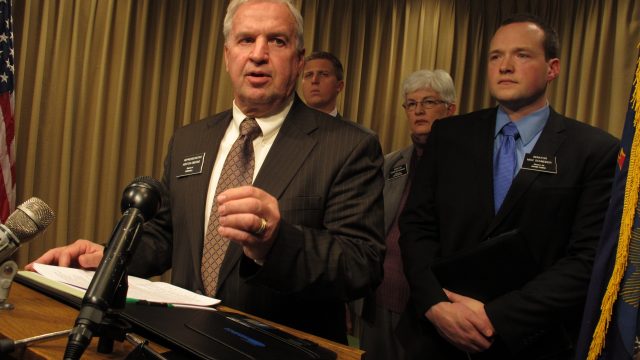North Dakota Democrats Spread Wildly Inaccurate Information About Oil Tax Collections

Yesterday Governor Jack Dalrymple announced that he would be calling state lawmakers back to Bismarck for a special session to run from August 2-4.
This move has prompted a lot of criticism of Republican handling of budget issues, some of it fair and some of it not so fair. One consistent talking point I’ve heard is that the state might not be in this spot had lawmakers not reformed the oil tax code during the 2015 session.
Where did that talking point come from? Democrats, it seems. In a column published in the state’s newspapers a couple of weeks ago Senator Mac Schneider and Rep. Kenton Onstad – the Senate and House Minority Leaders, respectively – claimed that the changes to the oil extraction tax pushed through by lawmakers was costing the state big (emphasis mine):
In the 2013 tax year alone, the effect of corporate and personal income tax reductions was more than half a billion dollars compared to the pre-2009 rates. The oil extraction tax cut, ramrodded through the 2015 Legislature in a matter of days during the close of the session, now is costing the state an estimated $11 million per month.
If this were a true statement it would certainly reflect poorly on Republicans. The problem is it’s an inaccurate statement. And not just a little bit inaccurate. It’s wildly inaccurate.
Nor is that statement a matter of opinion based on different ideologies or philosophies. It’s a matter of mathematics.
[mks_pullquote align=”right” width=”300″ size=”24″ bg_color=”#ffffff” txt_color=”#000000″]Not only does this chart show that the tax reform “ramrodded through the 2015 Legislature” is not “costing the state an estimated $11 million” as Schneider and Onstad claimed, but it has actually boosted oil extraction tax collections through the May production month by more than a million dollars per day.[/mks_pullquote]
First, let’s review what the Legislature did to the extraction tax. This is complicated because, let’s face it, the old tax was downright byzantine.
With HB1476, which took effect in December, lawmakers eliminated an exemption from the 6.5 percent oil extraction tax rate which kicked in when oil prices went below a certain per-barrel price (around $52 per barrel). Under current law oil companies pay the oil extraction tax no matter what the price of oil is. Under the old law they didn’t pay it when oil prices hit the trigger point, and the exemption stayed in place until prices were above the trigger price for five consecutive months.
In exchange for getting rid of that exemption lawmakers lowered the top oil rates. Under current law if the price of oil is above $90 per barrel for three months the top tax rate for the combined oil production and extraction rates is 11 percent down from 11.5 percent under the previous code (the production tax is 5 percent). If the price of oil is below $90 per barrel for three months the tax is 10 percent.
So how has this worked out for oil tax collections so far in 2016?
To get the facts I contacted Tax Commissioner Ryan Rauschenberger this morning and he provided me with a spreadsheet (see below) showing oil extraction tax collections for each month of the current year. Note that there is a lag in the numbers. For instance, taxes for oil produced in January are collected in February and distributed in March. Because of this the last month for which data is available is May.
Based on those numbers I put together a chart showing actual extraction tax collections versus what would have happened had the old tax code been in place. Not only does this chart show that the tax reform “ramrodded through the 2015 Legislature” is not “costing the state an estimated $11 million” as Schneider and Onstad claimed, but it has actually boosted oil extraction tax collections through the May production month by more than a million dollars per day.
Or about $37 million more in revenue per month on average:

Here’s a comparison of cumulative extraction tax revenues through May of 2016. The state has collected so far this year collected over $187 million more in revenues than it would have under the oil tax code:

Why is the state collecting so much more revenue after the reforms? Because oil prices would have been below the trigger if North Dakota Democrats had gotten their way, and the state would have had hundreds of millions of dollars of additional revenue shortfalls.
Rauschenberger told me that oil companies are currently paying an effective extraction/production tax rate of about 9.8 percent (there are still some old stripper well exemptions in place), but under the old oil tax code they would have been paying an effective rate of about 6.1 percent from December, when oil prices would have invoked the trigger, to present.
That’s a significant difference, and a big reason why Republicans pushed through this reform over objections from short-sighted Democrats. The trigger exemption made the oil tax code wildly unpredictable both in terms of tax burdens for the industry and tax collections for the state. Getting rid of the extraction tax exemption removed the uncertainty, and because it represented a big increase in taxation from the previous status quo, it only made sense to give the industry lower tax rates overall.
In the short term this has meant more revenue stability for the state, as the numbers above prove, while in the long term the industry gets slightly lower taxation when oil prices are high.
That sounds like a win-win. No wonder Democrats have to mislead the public about the oil tax reform to make it seem sinister.
[scribd id=318289958 key=key-PA2v67ysU7GCp6iTAa52 mode=scroll]




